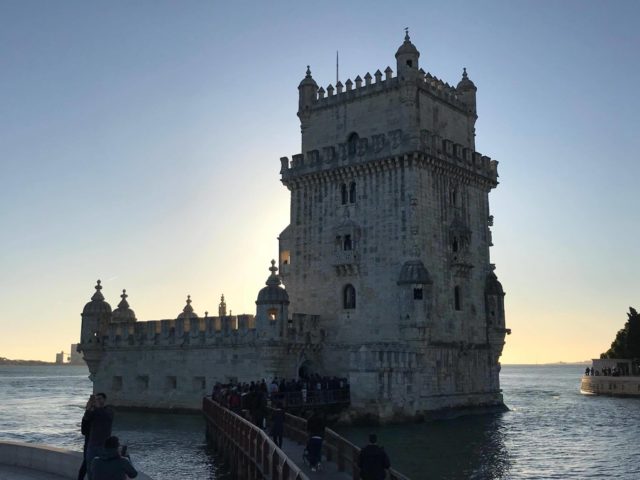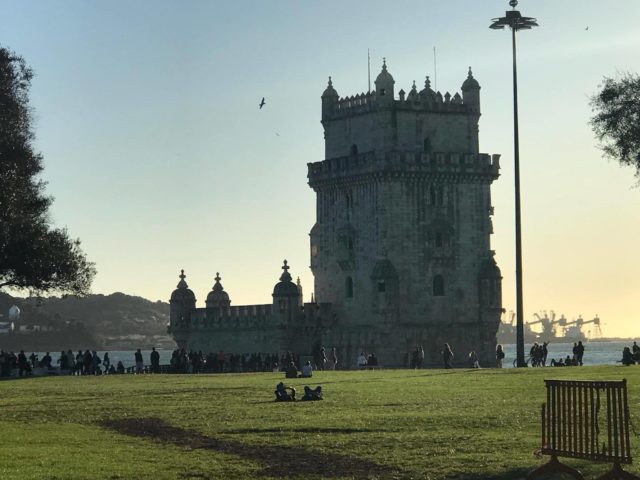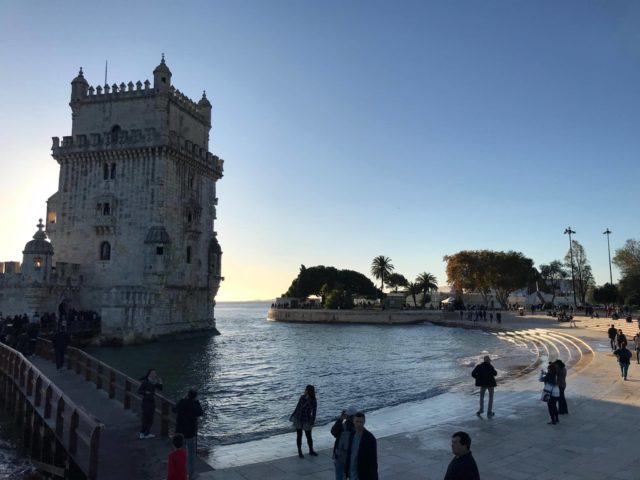
In Lisbon, the Belem district is one the most picturesque areas in Portugal’s capital. Many great Portuguese explorers, such as Bartholomeu Dias, who rounded the Cape of Good Hope, Vasco De Gama, who discovered the sea route to India, and even Ferdinand Magellan started their voyages of discovery from Belem. Moreover, their colleague Christopher Columbus took something of a coffee break at this place after he completed his discoveries of the New World.
This period was an affluent one for Portugal, since wealthy men made investments and witnessed the construction of Vasco da Gama’s resting place—the Jeronimos Monastery–as well as the astounding Belem Tower, which bade farewell to a great number of sailors who commenced their adventure in the Tagus River before facing the vastness of the Atlantic ocean. To many of them, this tower was the last sight of their homeland.

Belem Tower- Lisbon, Portugal
The Belem Tower is Lisbon’s most famous landmark, standing in the middle of the Tagus River. It was constructed between 1514 and 1520 as a fortress to guard the entrance to Lisbon’s harbor and protect the city. The monument’s exceptional architecture and its historical significance symbolize Portugal’s Age of Discovery and elevated its significance as one of UNESCO’s World Heritage monuments.

The famous landmark
There’s hardly any visitor who hasn’t been captivated by the significance and gracefulness of this building. Hours slip away while you stand and admire its gorgeous facade that faces the river or while your eyes wander over the views that stretch from the building’s windows and loggias. If you look around, you’ll find yourself surrounded by ancient lioz limestone that reflects the distinctive Portuguese “Manueline” style (named after King Manuel I) according to which the tower was made. This style features motifs that present the mainstream of the Age of Discovery, including the return of Vasco De Gama from his explorations to the Far East. The eastern influences can be traced in the Moroccan, Indian, and Venetian-inspired designs that fuse with common nautical symbols.

Belem Tower symbolize Portugal’s Age of Discovery
Reportedly, the king had a great interest in exploration and supported it as shown by the carvings of armillary spheres at the entrance of the tower. Walk around and you’ll instantly come across the main details of the Manueline style — ropes, harbors, knots, crosses, and armillary spheres.
An intriguing dominant element in the design is the stone rhinoceros that tells the story of an Indian king Modofar of Cambay (former Portuguese colony in India, today called Khambhat) who in 1515, sent a rhinoceros as a diplomatic gift to the king of Portugal. When the animal arrived in Lisbon it became a real attraction throughout Europe. The rhino was the first such exotic animal to ever set foot in the Western world. King Manuel exhibited the rhino in the park of the Palace of Ribeira but quickly became bored with it and decided to send it to Pope Leo X as a gift. Unfortunately, on the way to Italy, the ship that carried the rhino sank. Later, between 1514 and 1520, stone masons decided to carve the rhino and memorialize the entire story by incorporating it into a turret on the tower. Interestingly, even the famous German artist Albrecht Dürer, who never saw the rhino in person, was inspired enough by it to make a famous woodcut known as Dürer’s Rhinoceros.
The stone image which faces the river is the so-called Our Lady of Safe Homecoming, whom many believed protected sailors and promised their safe return. The terrace on the roof provides views over the Tagus River, the Belem district, and its historical hot spots. The lower terrace is in the Moorish style, surrounded by six turrets with small windows. In the past, this was the main spot of soldiers and guardians. Each of the tower’s floors includes small balconies, so regardless of where you look, you will definitely enjoy the scenery. The largest balcony contains Manueline as well as Venetian elements, facing south and overlooking the breathtaking Tagus estuary.

The Tower of Belém on the bank of the Tagus River
Namely, at the time, 16 cannon holes were responsible for the defense of Lisbon. The smoke caused by the artillery’s firing was ventilated through a small cloister surrounded by Gothic arches. If you continue sightseeing, you will get to the vaulted part on the final level of the tower which used to be a dungeon for holding political prisoners. But watch your head and don’t stand up as the ceiling is very low.
Finally, after soaking in these Portuguese delights, you can step out and observe it from a distance. If you look carefully, you’ll see two sculptures on the facade—one of St. Michael and the other of St. Vincent, the patron of Lisbon.
